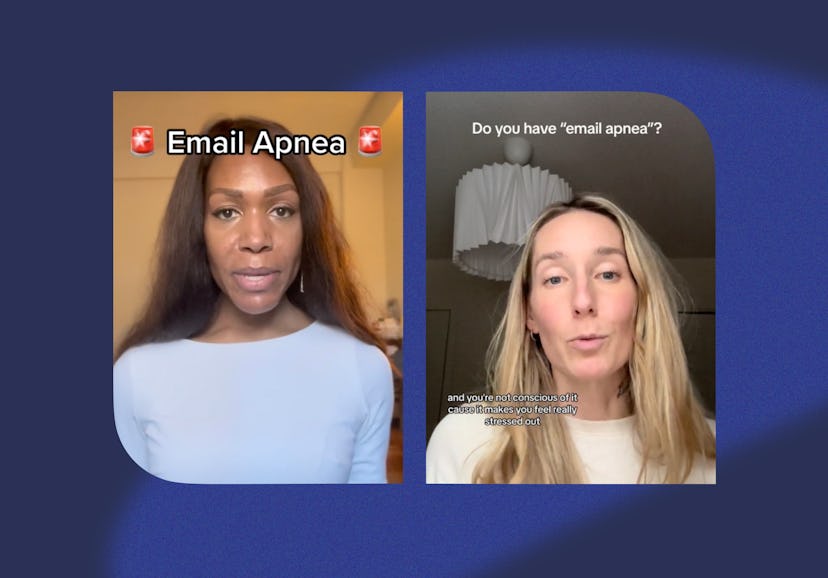Wellness
“Email Apnea” Might Be Why You Feel So Stressed Out At Work
You could be doing it right now.

When you open your inbox, you’re greeted by dozens of unread messages, issues that need to be resolved, and replies that need to be sent. Sometimes the stress of it all can cause you to hold your breath as you focus, scroll, and read, and it’s something to be aware of throughout the work day.
This phenomenon is known as email apnea, and it’s currently a viral topic on TikTok. According to Christina Gibson, MD, a family doctor, trauma therapist, and Ayurvedic counselor, apnea is a temporary stop to breathing that can happen involuntarily while you sleep, but it can also happen unintentionally during the day, like when you’re focused, anxious, or overworked.
A 2023 study showed that 80% of people hold their breath, breathe shallowly, or change their breathing patterns while looking at emails. This form of apnea mainly refers to emails, since those are particularly stress-inducing, but it can also kick in as you stare at social media, text friends, etc.
On TikTok, creator @acheloawellness said she holds hers while focusing at work. She’ll let out long exhales throughout the day, and sometimes they’re so loud her coworkers notice. Creator @aysha.yoga says email apnea can happen when you’re stressed and focused in the moment, but the habit can also create a vicious cycle that causes more tension and fatigue in the long run.
Here’s what to know about email apnea and what you can do to breathe normally again, according to experts.
What To Know About Email Apnea
The next time you’re powering through your inbox, pay attention to your breath and you might realize you’ve been unintentionally holding it in for hours. According to Gibson, email apnea is a habit some people develop to keep their body steady as they zero in on a task. Shallower breaths hold you still, she says, and that might make it feel like you’re locked in or focused on a task.
Email apnea can also be a natural extension of a long exhale, which is something you might let out when you’re feeling on edge. “Your inhales activate your sympathetic nervous system, or the nervous system of movement and action, while your exhales are more dominated by the parasympathetic nervous system, or the ‘rest and digest’ system,” says Gibson.
When you’re trying to calm down — especially while responding to particularly demanding emails — you may breathe out to release jitters from your body, and then you might sit there at the bottom of the breath without properly inhaling again. “A really long exhale, to the point where you reach apnea, might result from a person who is either trying to calm down restlessness or who is stuck [in a freeze state],” she says.
It might not sound like a big deal to breathe a little shallower while you respond to messages, but improper breathing can impact your stress levels as your body remains tense, and that can lead to stress-related health issues that impact your well-being.
It also does more harm than good when it comes to focusing. “Shallow breathing does not release enough carbon dioxide from the body,” says Gibson. “If your breaths are so shallow that you’re hyperventilating, this carbon dioxide can build up and make you dizzy and confused, and that’s definitely not optimal when you’re reading emails that are important.”
How To Deal With Email Apnea
Gibson recommends picking up a few “conscious breathing habits” to practice throughout the day. “If work is something that can get overwhelming, breath is one of the many tools that you can use to regulate your nervous system,” she says. Here are a few tips.
Check In With Yourself
Preventing email apnea could be as simple as checking in with yourself while you work to ensure you’re inhaling and exhaling at a steady, comfortable pace. Make a mental note — or set a timer — to remind yourself to breathe naturally, even when you’re super busy.
Take More Breaks
On TikTok, creator and yoga teacher @pranayamarose suggested stepping away from your screens periodically throughout the day to relieve tension — and to get a literal breather. Going for a walk is a good way to cope with anxiety.
Have A Moment Of Meditation
You check your inbox multiple times a day, so why not use those moments to purposefully focus on your breath? That way you’ll tackle your messages and give yourself a much-needed moment of Zen. “Listening to a low-frequency noise, pink noise, or brown noise can also relax the nervous system,” says Gibson, so play some in your headphones as you reply.
Try Longer Exhales
Feeling tense? Focus on extending your exhales for a few seconds as you breathe out. According to Gibson, longer exhales really help release tension from the body, just as long as you remember to fully breathe back in again. “For some people, putting a hand on their chest or their belly might also be calming and help them bring the breath under conscious control if it has been subconsciously held,” she says.
Maintain Good Posture
On TikTok, creator @beingmethod shared another remedy for email apnea, and it’s as simple as sitting up straight. When you’re at your desk, maintain good posture as a way to stay present in the moment. Feel yourself supported by the chair and keep both feet firmly on the ground as you clear out your inbox, and you should feel way less stressed by the end of the day.
Studies referenced:
Slowik, JM. (2024). Obstructive Sleep Apnea. In: StatPearls [Internet]. Treasure Island (FL): StatPearls Publishing; 2024 Jan-. Available from: https://www.ncbi.nlm.nih.gov/books/NBK459252/.
Sources:
Christina Gibson, MD, family doctor, trauma therapist, Ayurvedic counselor